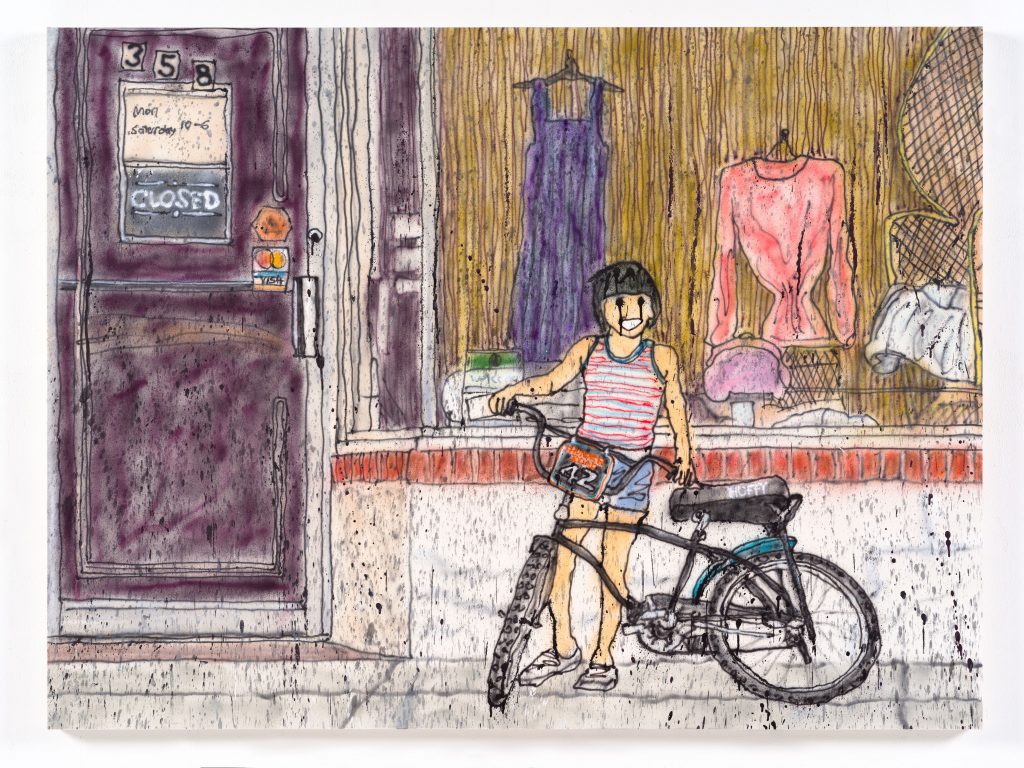
47 x 63 inches. ©2021 MADSAKI/Kaikai Kiki Co., Ltd. All Rights Reserved.
Courtesy Perrotin.
This spring and summer, New York City’s art scene clearly began to recover its energy—and audiences—after a full year of Covid-19 shutdowns and restrictions. The situation may not be back to “normal,” but each gallery and museum I visited managed to project some credible version of normalcy. Artists helped provide art audiences with some hopeful horizons and guiding stars to intellectually and emotionally navigate a post-pandemic world. In the museums, a survey of works by Alice Neel at the Metropolitan Museum of Art, a Julia Mehretu painting retrospective at the Whitney Museum of American Art, and an expansive Paul Cézanne drawings show at the Museum of Modern Art, began to attract large numbers of museum-goers for the first time in over a year.
The city’s gallery offerings this season also proved to be vital and exciting. Below is an overview of some of the most memorable, recent and current exhibitions that seem resonant and pertinent to today’s art world reemergence. Shows of relatively traditional mediums like painting, drawing, and sculpture were standouts—no doubt the result of intense, solitary activities of the individual artists. Unlike the more collaborative endeavors of film, video, performance, and interactive installations, these works convey the feeling of isolation that many of us experienced during the past year.
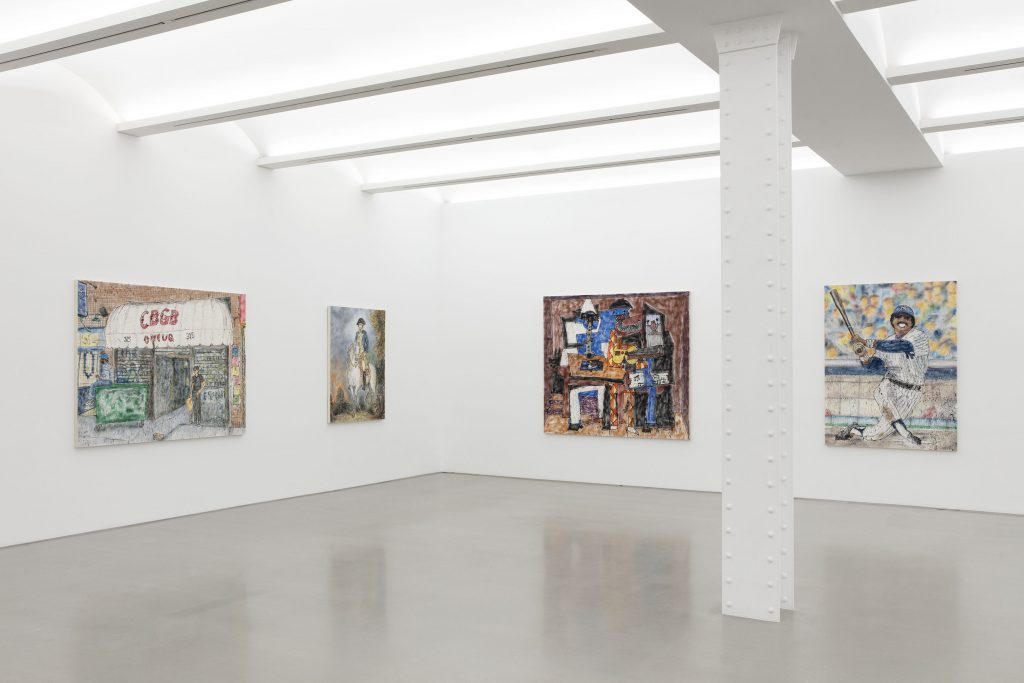
Friend (I’ve come to talk with you again) at Perrotin New York, 2021.
Photo: Guillaume Ziccarelli. Courtesy MADSAKI/Kaikai Kiki Co., Ltd.
Courtesy Perrotin.
1.) MADSAKI at Perrotin
MADSAKI’s first major New York solo show, Hello Darkness, My Old Friend (I’ve come to talk with you again) is/was the most haunting of the post-pandemic exhibitions I saw this season. An untitled image of an adolescent in a striped tank-top dismounted from a bicycle in front of a shop with a “CLOSED” sign, seemed to me emblematic of the pandemic year. The figure’s eyes running with black tears—a MADSAKI trademark—conveyed a sense of angst and isolation like no other. There were more forlorn offerings elsewhere in the show, but there was also a great deal of humor, and an uncanny take on the periodic absurdity of life. My initial response to the exhibition was positive, but its full impact took some time to realize.
The Japanese-born, New Jersey-raised, and Tokyo-based artist filled two floors of the gallery with large paintings featuring a broad array of images, spanning sports stars, art, pop culture, history, and recent political events torn from news pages. Titled after the 1964 song by Simon & Garfunkel, The Sound of Silence, the show (on view April 29–June 5) effervescently represented MADSAKI’s unique world view, and his own personal “lonerism.” I wondered if he is a fan of Tame Impala, the Australian rock band who elaborated upon the concept of “lonerism” in its 2012 LP. With an incredibly labor-intensive technique, using cans of spray paint (corresponding to graffiti art), MADSAKI manages to achieve surprisingly nuanced tonality, and intricate details of line and color in each work that never seem repetitious.
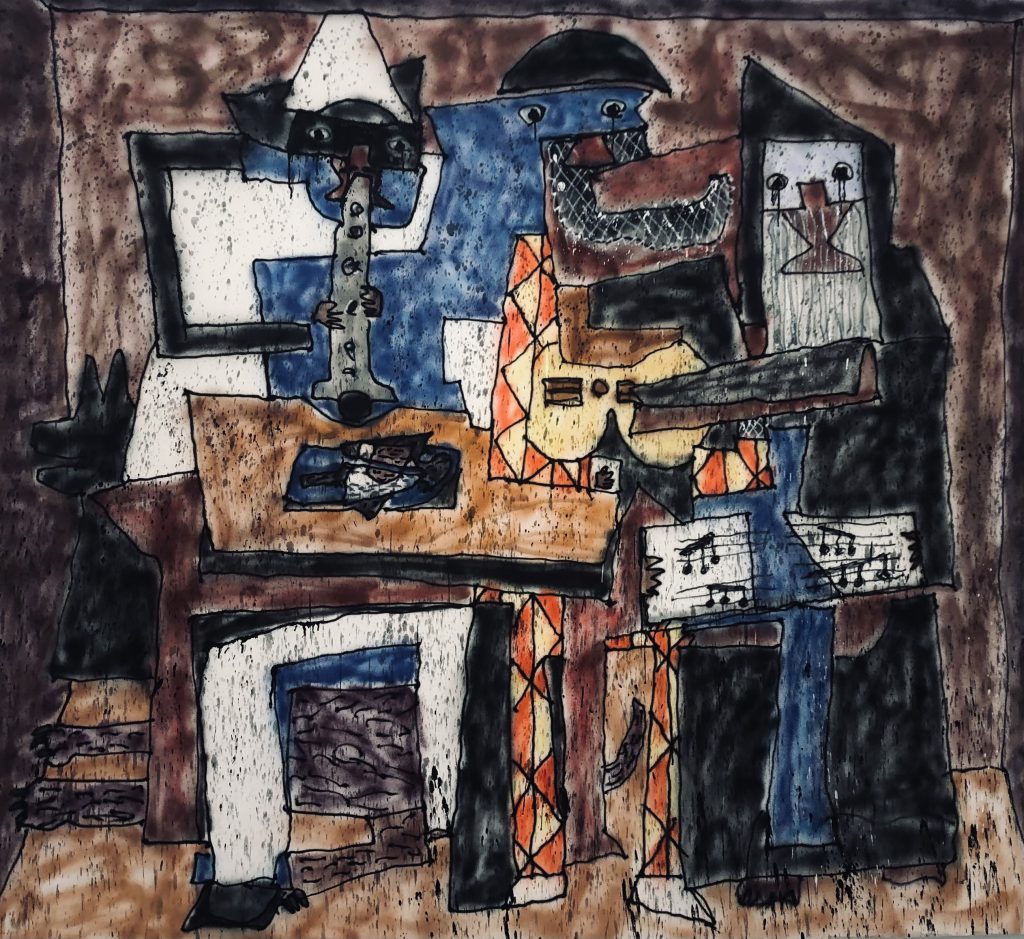
Courtesy Perrotin.
At the 2019 Frieze Fair in New York, MADSAKI had me laughing out loud with his wildly imaginative riffs on Francis Bacon’s iconic portraits and screaming popes. Here, Picasso was a riveting focus, with a lovingly rendered but bizarre interpretation of the Spaniard’s 1921 Three Musicians—the version in the Philadelphia Museum of Art, which made a substantial impression on me when I first saw it as a kid. According to the gallery press release, by curator Marc-Olivier Wahler, MADSAKI at first thought it was a depiction of Star Wars characters. This Picasso transcription, in MADSAKI’s capable hands, is no ordinary appropriation ploy. The bleeding eyes behind the musicians’ masks, certainly indicates its fateful acquisition by the artist as a key work in his own private rogues gallery of art-historical masterpieces.
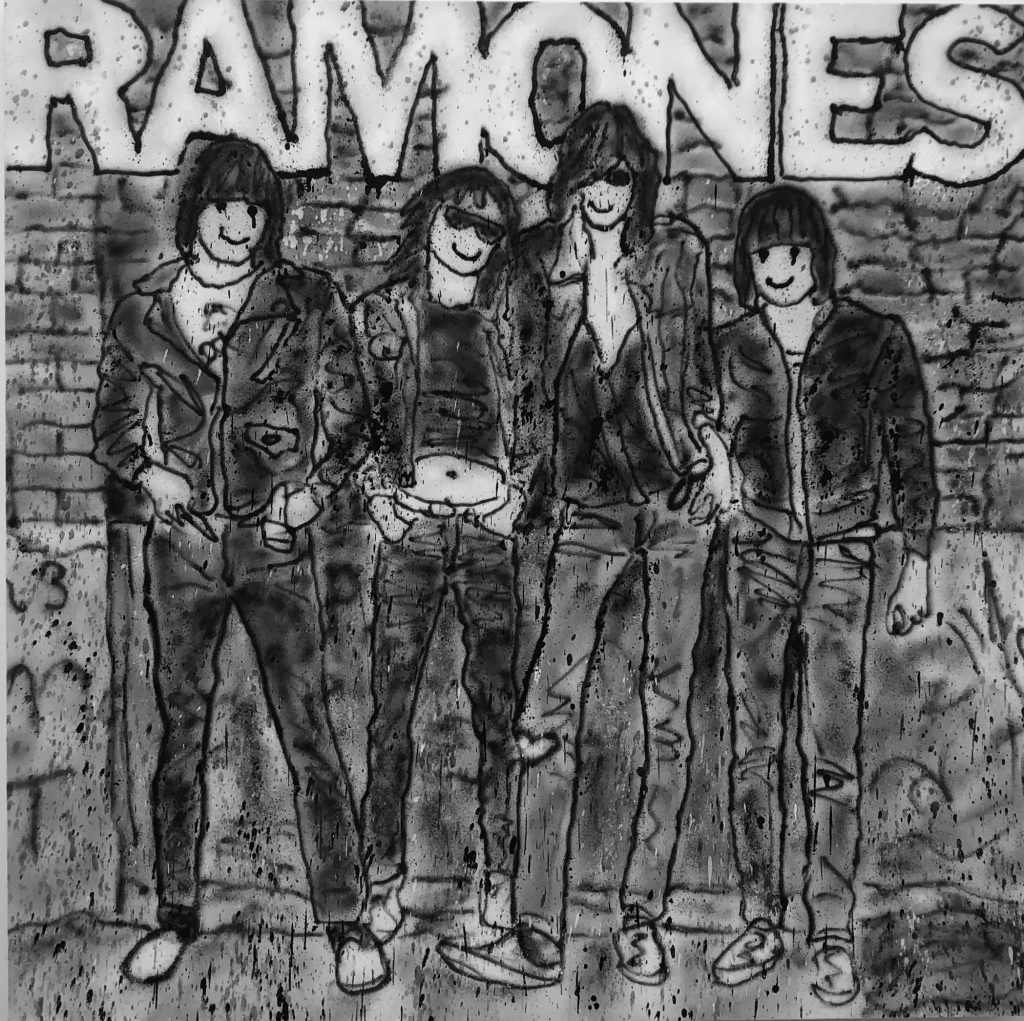
Courtesy Perrotin.
A special treatment of album covers—including LPs by the Cure, and a marvelous ode to the Ramones first album—are also welcome additions to the MADSAKI canon. The idea of emotionally reconnecting to certain records that were mantras in one’s youth, contributes to the feeling of melancholy and loneliness that the artist’s work often sustains. In this way, MADSAKI’s world would seem to be closer in spirit to Yoshitomo Nara’s introspective images rather than to the outré spectacles of his sometime mentor Takashi Murakami. In his stunning major US debut, MADSAKI has arrived, like Minerva, fully grown out of the art world’s pandemic-weary head.

Photo: Daniel Terna.
2.) Huguette Caland: Tête-à-Tête, at the Drawing Center, through September 19.
The multifaceted work and unorthodox career of Lebanese artist Huguette Caland (1931–2019) spans the worlds of art and fashion, and unfolds against a unique backdrop of Middle East politics, and the global feminist initiatives that mark the era. The daughter of the first president of Lebanon following the country’s independence from France, Caland studied painting and drawing at the American University in Beirut. She moved to Paris in 1970, where she struggled to establish herself as an artist and designer.
This wonderful show, organized by The Drawing Center’s chief curator, Claire Gilman, with curatorial associate Isabella Kapur, includes some 100 paintings, drawings, sculptures, and fashion designs, plus a wealth of archival material. It emphasizes Caland’s distinctive use of line and color in idiosyncratic works that encompass elegant and fluid figurative studies, geometricized compositions that recall urban mapping, organic forms, geological studies, and purely abstract works.

Courtesy the Drawing Center
In 1979, she was commissioned by fashion house Pierre Cardin to create a series of high-fashion caftans, a number of which are on view in the show. One striking example features the outline of a nude woman, while another depicts a crowd of cartoonish figures enfolded by the flowing garment. Caland moved to Venice, California, in the 1980s, and earned a reputation as a more or less cult figure. She eventually returned to Lebanon, and her later works—among the show’s most resplendent and unabashedly beautiful—such as Bodrum (2008), and Appleton I (2009), reflect her reexamination of Middle Eastern art, a contemporary homage to ancient textiles, ceramic, and embroidery.
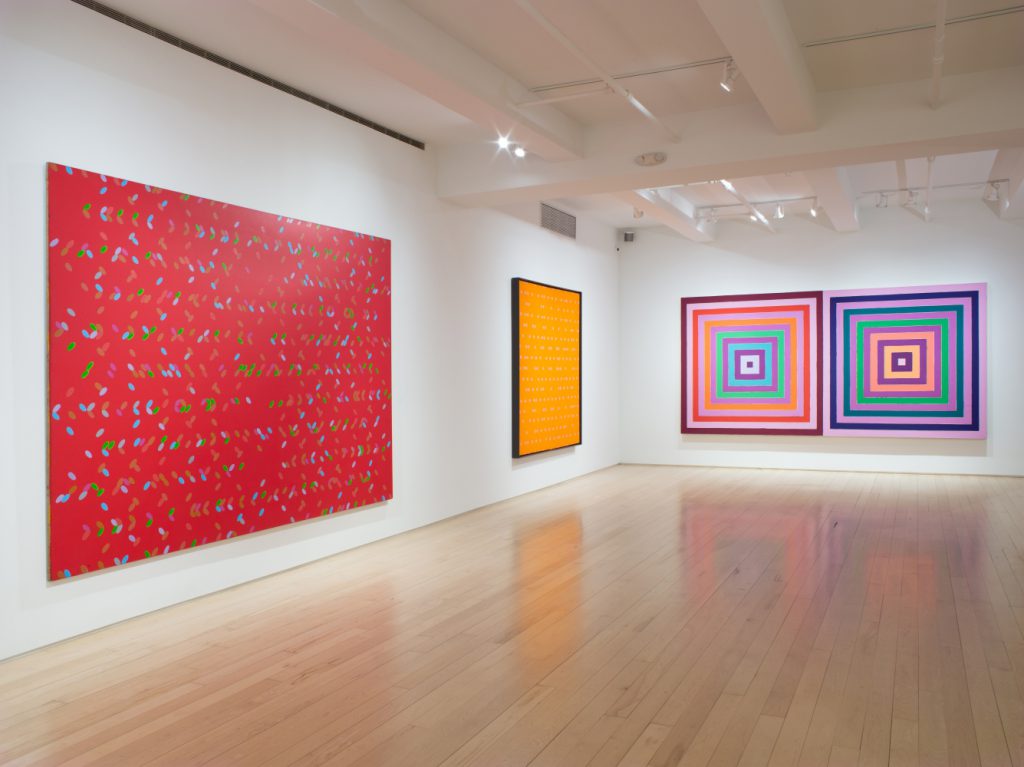
Photo courtesy Yares Art.
3.) Larry Poons / Frank Stella: As it Was, As it Is, Yares Art, through September 4.
Larry Poons / Frank Stella: As it Was, As it Is, is one of the most stunning and art-historically significant exhibitions of contemporary art on view in New York this season. The exhibition examines the longtime friendship of two pioneers of American abstraction, and the evolution of their works spanning almost six decades. Both artists, who share a love of racing (Stella, cars; Poons, motorcycles) have been correspondingly restless in their artistic pursuits, constantly thwarting expectations and challenging themselves with each new series of works. Early in his career, in the late 1950s, Stella (b.1936) paved the way for the development of Minimalism. A related work in the show, such as Double Concentric Squares (1974), with its brilliant color and expansive geometry, shows that he had already eschewed the Minimalists’ dogmatic rigor in favor of uncharted visual explorations. Likewise, key works by Poons (b. 1937), such as Orange Crush (1963), a riveting composition of colorful dots pulsating against a ground of contrasting hue, approaches the realm of Op Art, a genre that Poons sidestepped on his way to his more emotionally wrought Color Field innovations.
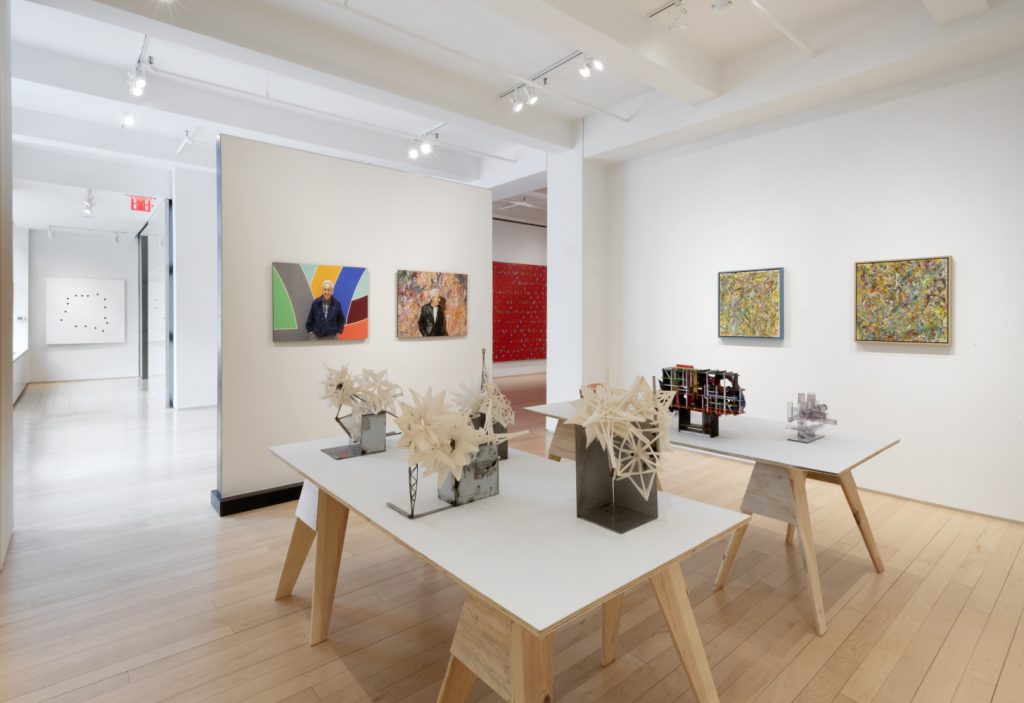
Photo Courtesy Yares Art.
In more recent years, Poons and Stella have continued to evolve and expand their explorations of abstraction. Stella has embarked on an incomparable examination of the “star,” a play on his last name as well as a conceptually resonate consideration of the star motif throughout history. Poons has returned to the fundamental principals of gestural abstraction, often painting with his hands, and offering perceptive viewers ever more vibrant and opulent pageants of light and color. Snap Editions‘ long association with Yares Art and its publications must be acknowledged here, but that relationship did not and does not impact my appreciation for this superb exhibition.

Photo: David Ebony
4.) Carol Bove at David Zwirner; and at the Metropolitan Museum of Art (through November).
With her recent muscular and elegant constructions in metal, Carol Bove embraces much of the history of post-war abstract sculpture, while ushering it into a new and vivacious place. No artist I can think of had a stronger 2021 spring and summer season, for Bove presented three major exhibitions of recent work in New York. In one of David Zwirner’s Chelsea spaces, she showed monumental works made of crushed and painted steel tubing (April 29–June 18). One element of each work is painted bright orange-yellow, and its supple surface conveys a sensuous, anthropomorphic countenance. The sculptures stood like imposing sentinels in a room whose black-painted walls contributed to the feeling of a nocturnal reverie.
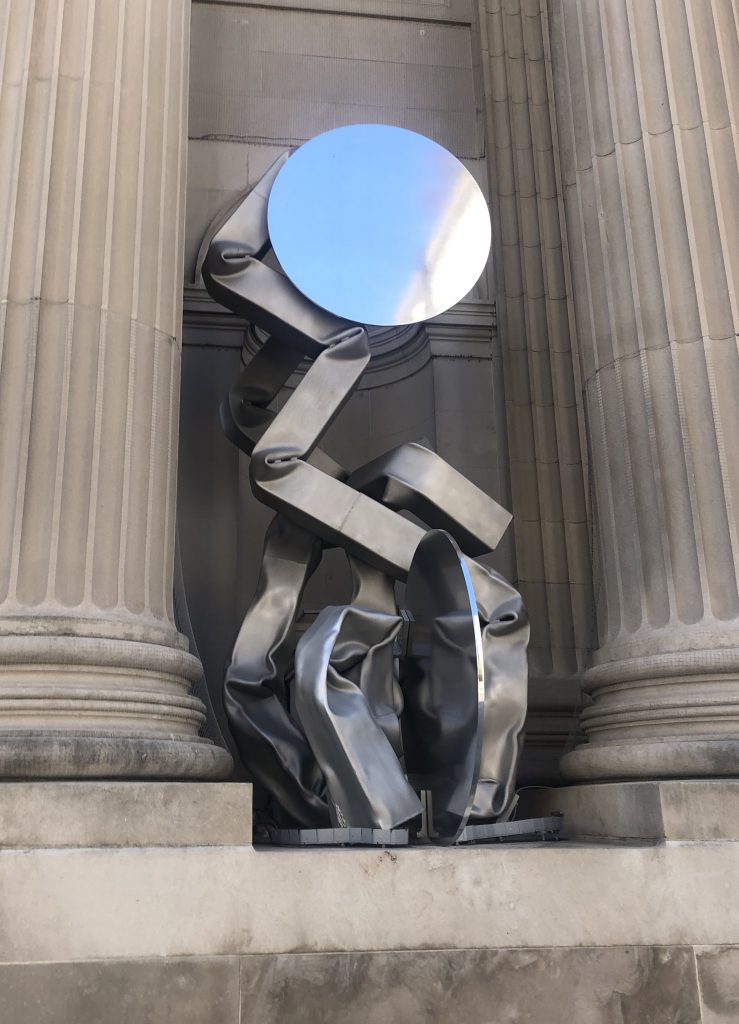
Photo: David Ebony.
The works at David Zwriner’s uptown venue were smaller and generally more colorful, each with a more or less horizontal thrust compared with the verticality of the large-scale works downtown. The artist covered the walls in one room with flowing fabric stained with warm coffee tones, which served as a backdrop for several metal table sculptures in white. The cloth complemented the orange and brown geometric shapes in a Josef Albers painting the artist hung on one wall.
In formal terms, Bove’s sculptures sometimes suggest the work of artist predecessors like David Smith, John Chamberlain, Donald Judd, and Lynda Benglis. Bove further engages art history in her most ambitious effort to date, the recent commission for the Metropolitan Museum of Art façade, The séances aren’t helping, featuring four sculptures made of polished stainless steel disks and aluminum elements, which suggest colossal figures. Here, she connects the experiments of modernist and contemporary abstractionists with the grand traditions of Renaissance and Beaux-Arts sculpture and architecture, as well as classical Antiquity. As she comments on the commission in a press statement for the Met, “When the disks catch the sun as it rises, it might recall a dazzling Egyptian temple.” And so it does.
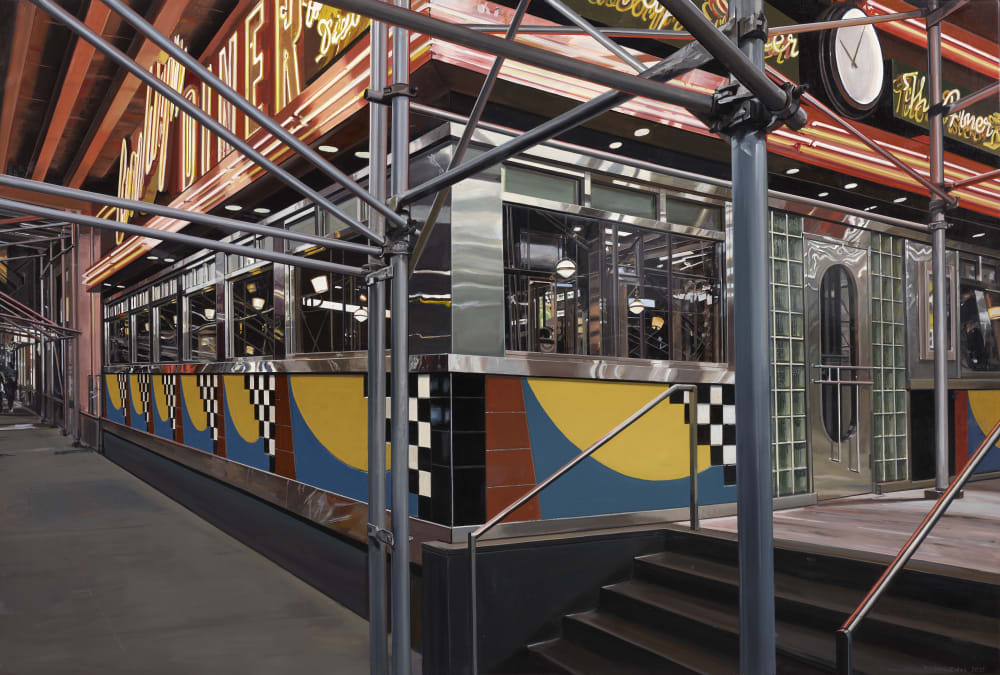
5.) Richard Estes at Menconi + Schoelkopf, through July 30.
Best known for his paintings of urban street scenes with indeterminate layers of images reflected in store front windows and stainless steel facades, Richard Estes has also applied his precisionist technique to landscapes of the Galapagos, Antarctica, Nepal, and other exotic locales he has visited. Fine examples of these and other images appear in this concise and splendid survey covering the past four decades of his long career. One of the pioneers of Photorealism, Richard Estes uses his own photographs only as reference points in his painting process. Unlike most practitioners of the genre, he does not rely on projections or gridded surfaces to realize his paintings. The resultant works reproduce well as super-realist images, but the excitement of Estes’ paintings and works on paper are more fully appreciated up close. His subtly nuanced line and color, and the rich surface textures are full of life, light, and energy.
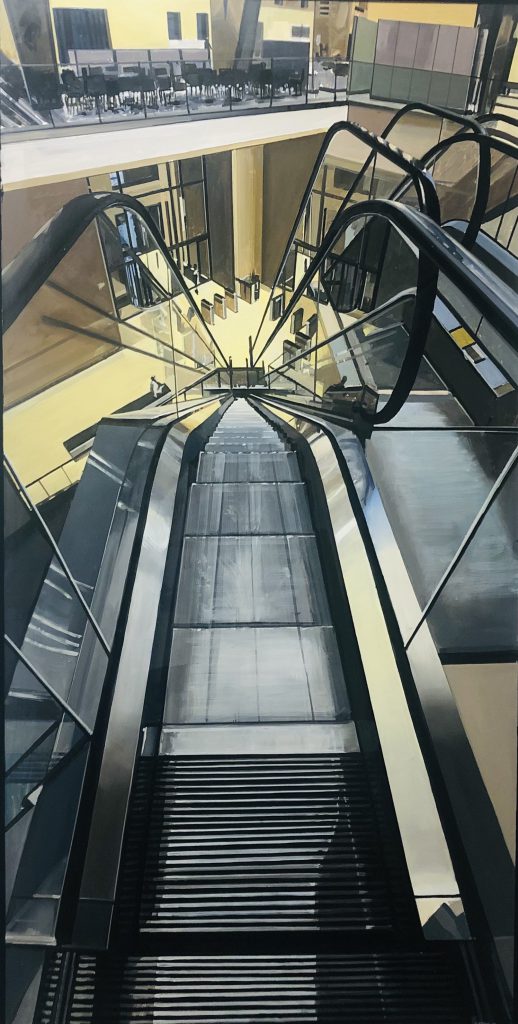
Among the revelations of this exhibition is the inclusion of several recent works, such as Brooklyn Diner and Escalator in Hearst Tower (both 2021), which show the artist, now 89, creating some of the best works of his career. The former, a familiar theme for the artist, features a network of imposing scaffolding pipes that obscures a full view of the diner’s façade. The skewed and surprising spatial relationships here contribute to the intense dynamism of the composition. Alluding to a dizzying trope, Escalator in Hearst Tower, with its extreme, and mesmerizing, downward visual sensation, conveys a unique sense of vertigo—a metaphor, no doubt, for this uncertain, unstable moment in time.

Installation view, Wangechi Mutu; Gladstone Gallery, New York.
6.) Wangechi Mutu, at Gladstone Gallery.
Otherworldly, though utterly convincing, antiquarian yet futuristic, Wangechi Mutu’s recent large-scale bronzes of hybrid human-animal creatures, with female features, address the fragile interrelationship of nature and humanity. In this show, one of the most memorable of the season (May 6–June 25), the Kenya-born, New York and Nairobi-based artist presented the bronzes in rooms whose walls were lined near the floor with an ash-like stain. It added to a feeling that these works could be archaeological relics, funereal pieces from the distant past. They appear as memorial tributes, perhaps to some long-lost species, particularly the female of a species that once ruled the planet, or perhaps will do so in the future.
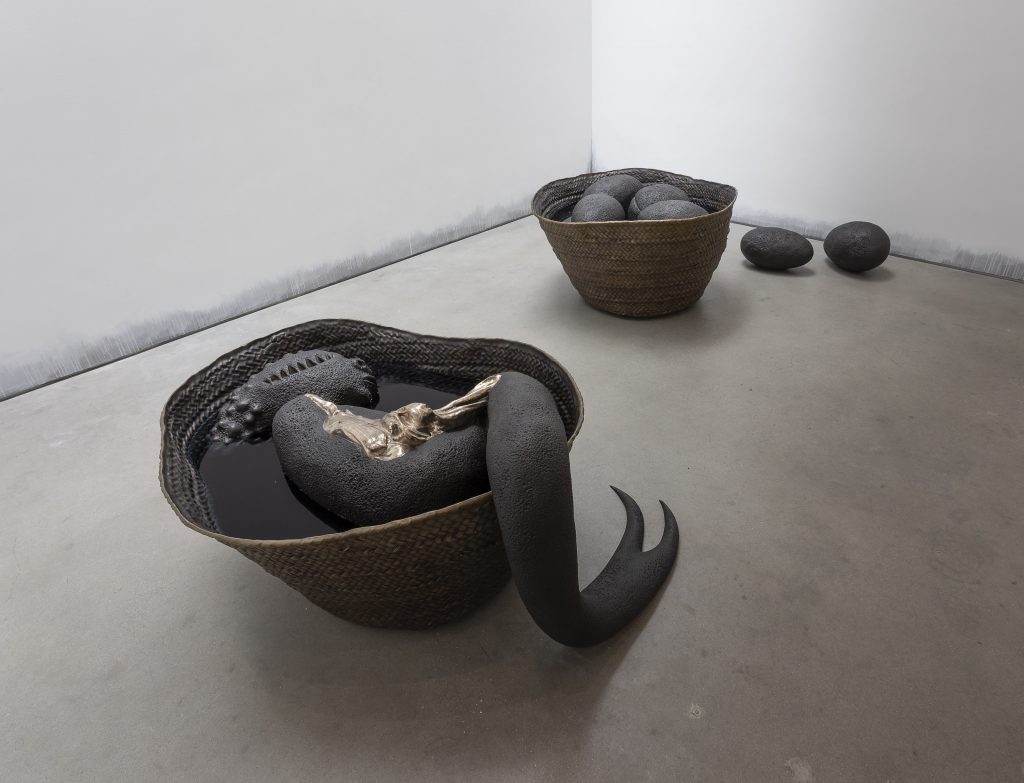
Installation view, Wangechi Mutu, at Gladstone Gallery, New York.
MamaRay (2020), consists of an enormous sting ray body with a woman’s head. Her intricately detailed headdress, adorned with highly polished beading, flows down her neck and sides like an elaborate cape that becomes part of the ray’s body. Crocodylus shows a stylized female figure riding an enormous crocodile. The patterning on the woman’s head and arms merges with that of the beast, indicating some seismic, morphological event. Elsewhere, a serpentine-looking creature lies in a basket filled with some curious liquid. The golden patina covering one area of the body suggests a life-sustaining substance, while a nearby basket is filed with the eggs of future reptilian progeny. With this rather arcane exhibition, Mutu has created a unique mythological realm.
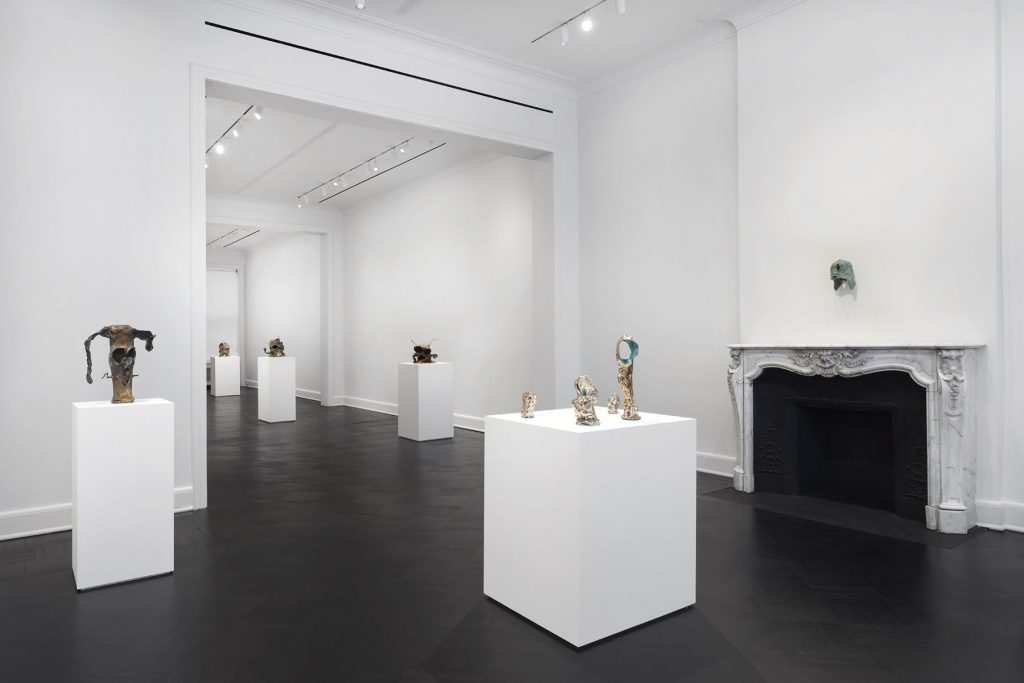
7.) Jon Pylypchuk at Petzel, through August 6.
Leave it to Los Angeles artist-prankster Jon Pylypchuk to come up with one of the season’s most elegiac and emotionally engaging exhibitions about love and loss—of lives and human contact—befitting the past pandemic year. A show of modest-scale, unique bronzes that are at once goofy and profound, Jon Pylypchuk: What we have missed features intimate works, which the artist refers to as “ghost” sculptures. Personal memorials to a recently and suddenly deceased dear friend, most of the pieces are articles of clothing cast in bronze—often men’s underwear, presumably worn by his departed friend. The leg or arm holes of the garments serve as gapping eyes, mouths, or noses of faces—alien creatures, or simply forlorn folks—that are by now integral features of Pylypchuk’s iconography.
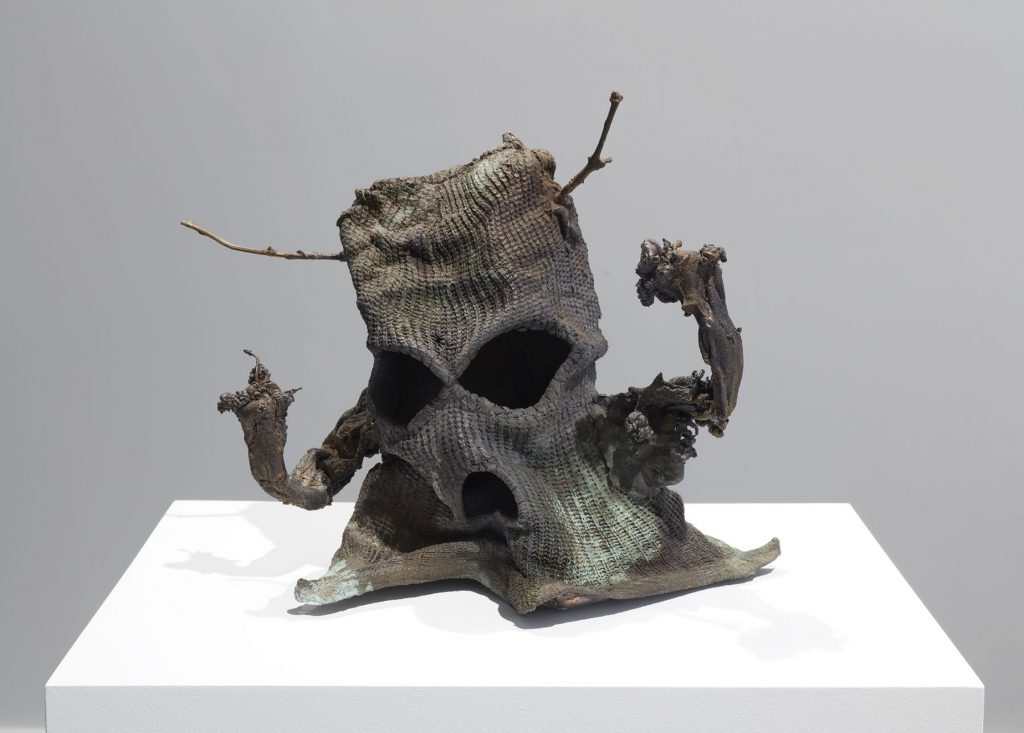
For some works, twisted strips of cloth, connoting arms and hands, convey surprisingly expressive gestures of grief, pain, and perhaps some anger. One of the more complex sculptures, Untitled (Pietà), 2020, shows a pod-like “body” holding on its “lap” a misshapen form, ostensibly a corpse. Pylypchuk is no Michelangelo, but the sculpture is not exactly grotesque either; the work’s mournful spirit is clear. Other works have an archeological feel, such as a small wall-hung bronze with a green patina, which suggests a battered helmet, or a Medieval relic of some sort. In this show, Pylypchuk offers a meditation on the passage of time, and, as the title suggests, a contemplation of what we have missed over the past year or more.

8.) Tom LaDuke at Miles McEnery, through July 31.
In his recent, and most dazzling paintings to date, Los Angeles artist Tom LaDuke has defined (or perhaps “discovered” is a more accurate term) a refined kind of Superrealist space that is not of this world, yet familiar all the same. It is an elusive space, for sure, but I hesitate to call it abstract, since most of the paintings recall a brightly lit interior, like that of a typical contemporary art gallery space. In the paintings, white walls are punctuated here and there with passages of even more blaring white, like spotlights or floodlights. Each of these large-scale compositions invite the viewer into a pristine gallery, just like the one in Chelsea where these pictures now hang.
What goes on inside the painted “rooms” constitutes another sort of visual and cerebral workout for the viewer. In each painting, a palpable burst of energy emanates from the more or less central area of the composition. In Houses of the Holy (2021)—highly conducive to an accompanying Led Zeppelin soundtrack, I imagine—an elongated and violent swath of dark gray, like a cosmic cloud, rushes through the center of canvas. This passage of unruly ether seems to be anchored in the space of “the room” by a bravura passage of a colorful hook—stripes of rich impasto brushwork in the form of a backwards “C” on the lower right.
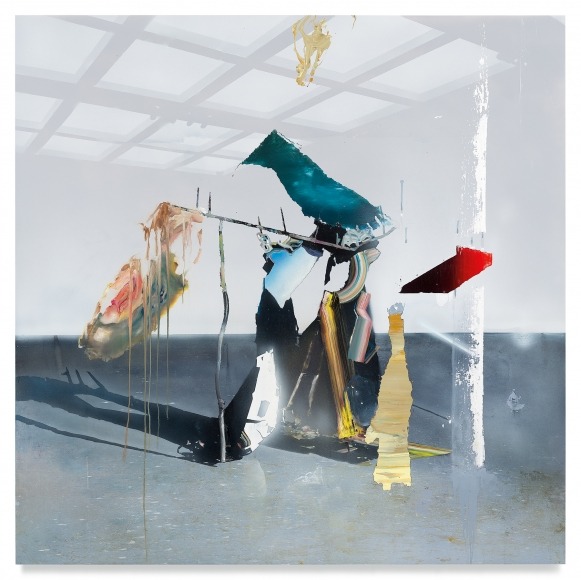
Tongues of Grace (2012) is even more exacting in its rigorous spatial play. Here, what appear to be gallery skylights illuminate painterly patches of contrasting color, light, and infinite spaces. Suddenly, foreground and background dissolve, and a contradictory reality takes holds, intentionally disorienting the viewer in summery fashion. Thankfully, LaDuke offers a glimpse of another dimension, another world, perhaps, as an alternate reality that is thrilling to behold and contemplate in these trying times.
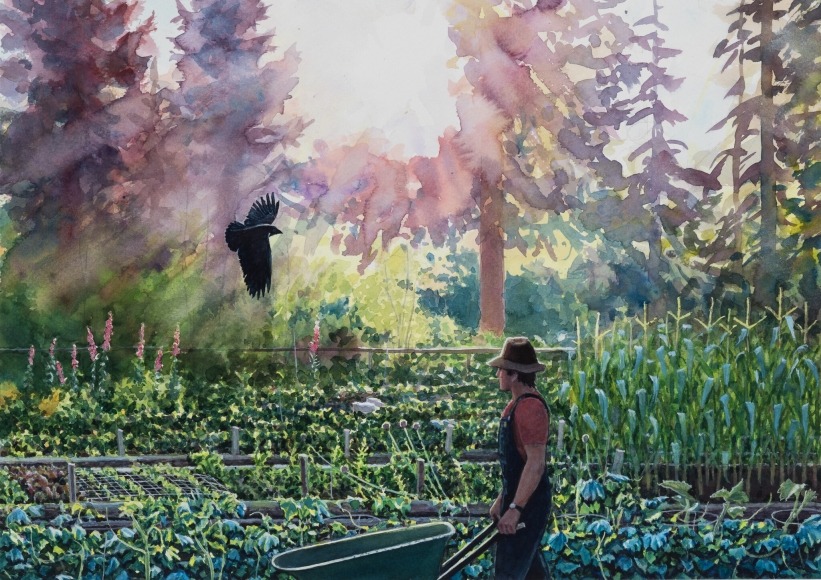
9.) Tim Gardner at 303 Gallery, through August 13.
Tim Gardner’s images are typically derived from a vast archive of found photos. But his ultra-refined works on paper are anything but derivative. The Iowa City-born (1973) Canadian artist, who lives and works in British Columbia, transforms the source material into something distinctive, personal and transformative. This show of recent watercolors is unmistakably a result of the pandemic, and reflective of its impact on society. The desire to travel, and to re-explore a spiritual connection with nature are recurring themes. Venice Beach Buddha (2021), for instance, is a lovingly painted image of a seated Buddha statue surrounded by lush garden vegetation. No mere rendering of a sculpture, the painting itself assumes its own meditative purpose. In the Garden, (2021) is an unabashedly romantic image of a gardener with a wheelbarrow, pausing in his work to observe a crow flying overhead.
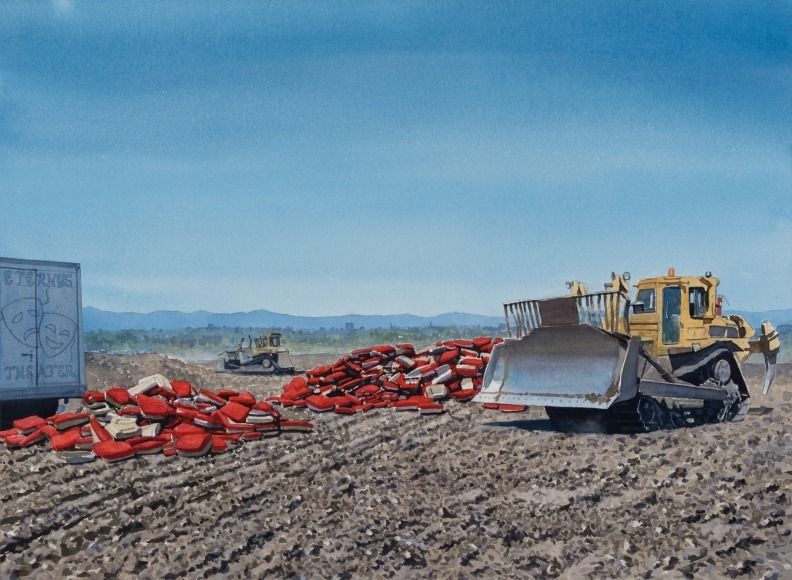
Watercolor. Courtesy 303 Gallery.
In Theater Seats, LA Landfill (2021), Gardener comments on the devastating impact that the pandemic has wrought on theater, performers, and the film industry, which had completely shutdown for more than a year. With the luminous, crystal blue sky, and the meticulously wrought bright orange chairs on the ground, Gardner underscores rather than offsets the scene’s feeling of desolation and despair.

10.) Miguel Cárdenas at Chapter NY, through July 30.
For this compact but evocative exhibition, Miguel Cárdenas presented a series of recent paintings, watercolors and sculptures with Surrealist overtones, but perhaps more closely akin to the Latin American tradition of Magic Realism. Born in Bogotá, Colombia, Cárdenas earned an MFA at Columbia University, and currently divides his time between New York and Bogotá. Paintings such as Bird Totem in a Landscape, with its brilliant pink sky, feature the fanciful animal and vegetal forms that often populate Cárdenas’s imaginative world. Especially prominent throughout the show is a long-beak bird that the artist has also rendered in quasi-abstract sculptures made of wood and aluminum that are among the highlights of the exhibition. The avian creature recalls Max Ernst’s bird Loplop (1930), which occurs in his work as his alter-ego, and no doubt plays a similar role for Cárdenas in his work.
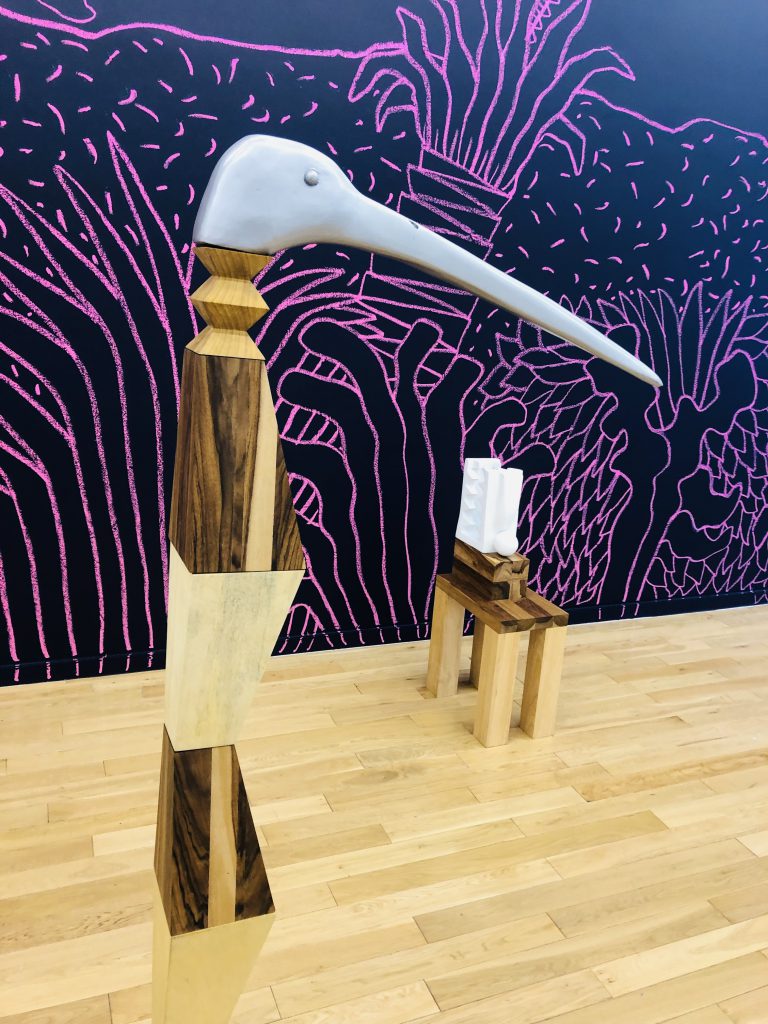
and site-specific mural, Tropical Landscape, 2021. Photo David Ebony.
Watercolor is a particularly fertile medium for Cárdenas’s wild imagination, and works such as Horse and Rider (2020), showing what appears to be a circus act on stage, have a singular dreamlike quality. For this show, Cárdenas created a site-specific mural that adorns one long wall. Titled Tropical Landscape, the mural consists of exotic vegetation rendered in hot-pink pastel against a blue-black background. The whimsical and vibrant jungle scene enhances the exotic world that the artist tenderly reveals throughout the show. On some level, Cárdenas offers pure escapism, a soothing balm for troubled times, and what more can you ask of a work of art?
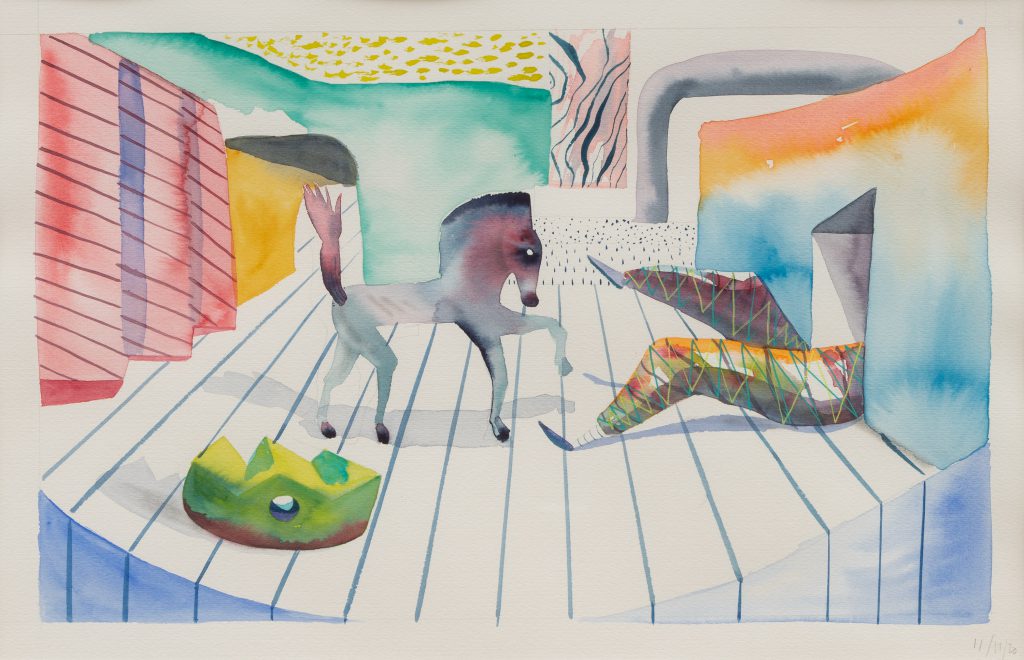
Text ©David Ebony 2021.
Thank you David! So good to see through your eyes! Just got back to NYC after a few months away; I only went to see Paul Cézanne quel régal. Hope we can catch up soon xx
Thu, Jul 22, 8:52 PM
Ooh, this is like getting to go to galleries with you without getting my feet wet or hailing a cab. Thank you. Suzanne
Muchas gracias David. Lo voy a leer luego. Espero que estés bien. Un fuerte abrazo desde Madrid.
I liked what a wonderful article wow how interesting i’m always learning more.
Your website is amazing congratulations, visit mine too:
https://b9g.net
.
[email protected]
Wow, this post has given me useful info and answered some of my questions. I hope to give something back and aid others like you helped me. Feel free to surf my website webemail24 about Website Design.
I know a lot of folks whom I think would really enjoy your content that covers in depth. I just hope you wouldn’t mind if I share your blog to our community. Thanks, and feel free to surf my website Seoranko for content about Online Music Streaming.
I know a lot of folks whom I think would really enjoy your content that covers in depth. I just hope you wouldn’t mind if I share your blog to our community. Thanks, and feel free to surf my website ArticleHome for content about Social Media Marketing.
I like the comprehensive information you provide in your blog. The topic is kinda complex but I’d have to say you nailed it! Look into my page Articleworld for content about Construction Industry.
With your post, your readers, particularly those beginners who are trying to explore this field won’t leave your page empty-handed. Here is mine at Article Sphere I am sure you’ll gain some useful information about Data Mining too.
As someone still navigating this field, I find your posts really helpful. My site is Article Star and I’d be happy to have some experts about Search Engine Optimization like you check it and provide some feedback.